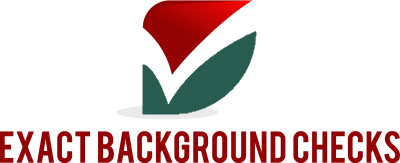Key Facts About Pre-Employment Drug Screen Cutoff Levels
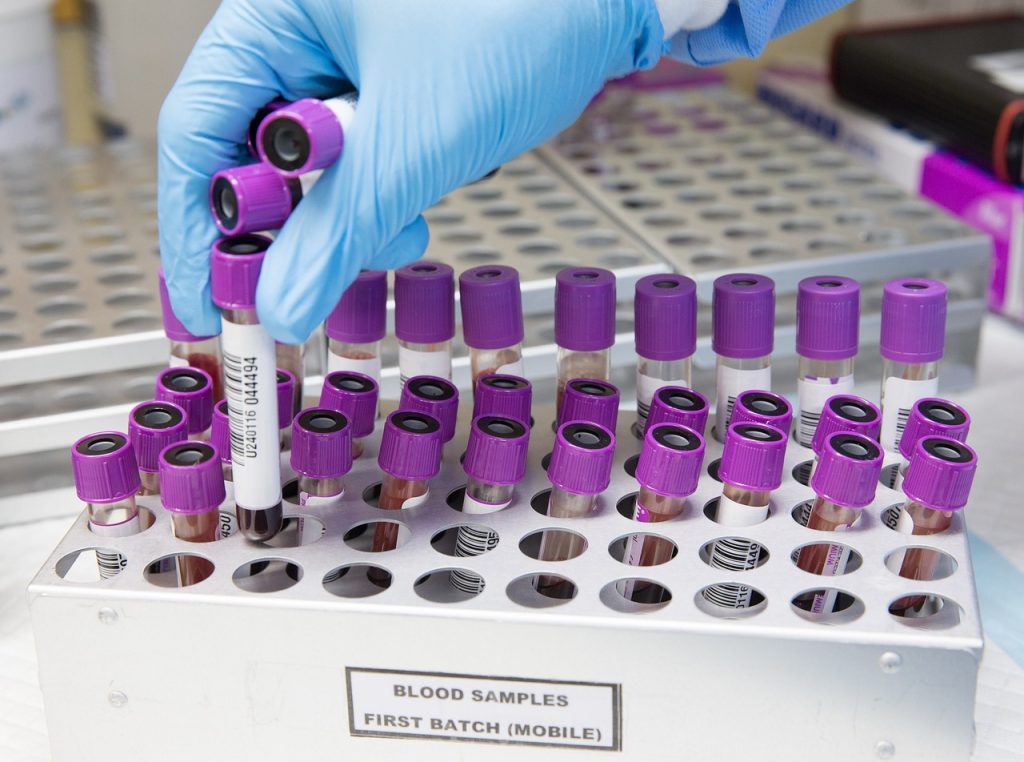
What are Pre-Employment Drug Screen Cutoff Levels?
Pre-employment drug screen cutoff levels are defined thresholds set by testing authorities or agencies that determine whether a particular substance in a drug test sample is present in sufficient quantity to produce a positive result. In simple terms, cutoff levels represent the concentration levels of specific drugs or their metabolites (the substances your body produces when it breaks down drugs) in the urine, blood, saliva, or hair samples being tested.
These cutoff levels are critical in ensuring that drug testing is accurate, fair, and consistent. They help distinguish between someone who may have a trace amount of a drug in their system from someone who is actively using or abusing drugs. Without these thresholds, testing could lead to false positives or false negatives, both of which can have serious consequences in the hiring process.
Why are Cutoff Levels Important?
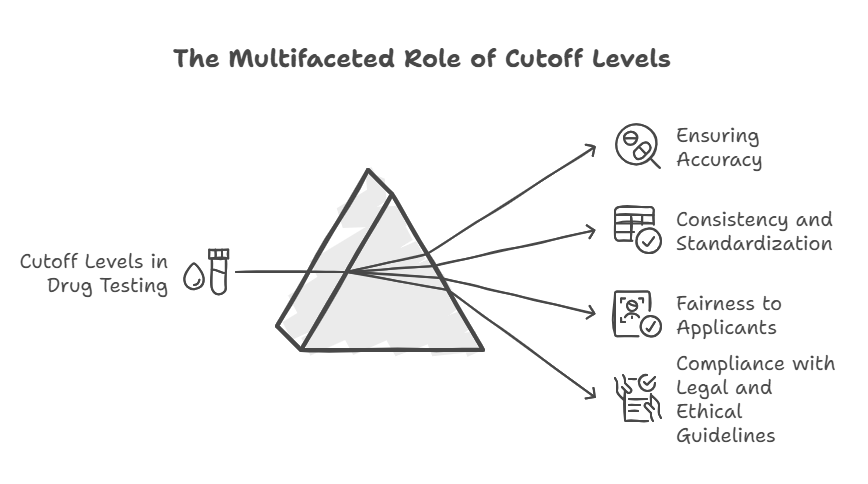
The importance of cutoff levels in pre-employment drug screening cannot be overstated. They serve as a standard to help employers and testing laboratories determine the presence and quantity of drugs in a sample. Here’s why these levels matter:
- Ensuring Accuracy: Cutoff levels are designed to detect only significant levels of substances, helping to avoid the detection of trace amounts that may have come from passive exposure or inadvertent contact (e.g., secondary marijuana exposure). This ensures that the test results are a true reflection of the individual’s drug use.
- Consistency and Standardization: By setting universally recognized cutoff levels, drug tests are standardized, which helps ensure fairness and consistency across different employers, industries, and testing facilities. The U.S. Department of Health and Human Services (HHS) and other regulatory agencies define these levels, making it easier to compare test results from different sources.
- Fairness to Applicants: Cutoff levels protect applicants from unfair testing practices. By setting minimum thresholds for detection, the system avoids penalizing individuals for occasional, low-level exposures to substances that do not indicate active abuse.
- Compliance with Legal and Ethical Guidelines: The implementation of standard cutoff levels ensures that employers remain compliant with legal and ethical guidelines regarding drug testing. This is especially important in industries regulated by federal laws, such as transportation and healthcare, where drug testing protocols are strictly enforced.
How Do Cutoff Levels Work in Pre-Employment Drug Screens?
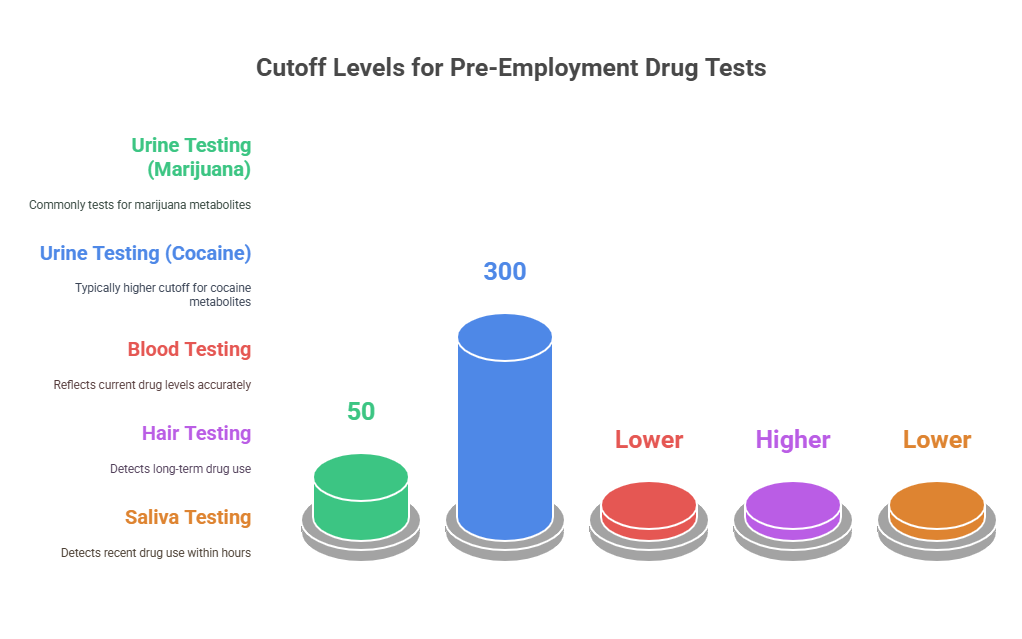
In a typical pre-employment drug test, candidates provide a sample (usually urine, but sometimes blood, hair, or saliva) that is tested for various substances. Each drug or metabolite has a specific cutoff level, which is the minimum concentration at which it will trigger a positive result.
For example, if the cutoff level for marijuana metabolites in urine is set at 50 ng/mL (nanograms per milliliter), any sample with a marijuana concentration greater than this threshold will yield a positive result. However, if the concentration is below the threshold, the test result will be negative, even if marijuana is present in the sample.
Here’s a breakdown of how cutoff levels work in the context of various drug types and testing methods:
- Urine Testing: This is the most common form of drug testing and has cutoff levels for substances like marijuana, cocaine, opioids, and more. For instance, the cutoff level for marijuana metabolites is typically 50 ng/mL, while for cocaine metabolites, it’s usually 300 ng/mL.
- Blood Testing: Blood tests are less common but more accurate in determining recent drug use. Cutoff levels for blood tests may vary and are generally lower than urine tests because blood reflects current drug levels more accurately.
- Hair Testing: Hair testing is often used to detect long-term drug use because drugs can stay in hair follicles for months. The cutoff levels for hair testing tend to be higher, but they provide a longer window for detecting drug use.
- Saliva Testing: Saliva testing is typically used for detecting recent drug use, often within a few hours or a day. Cutoff levels for saliva tests are usually lower than urine or blood tests and can vary depending on the drug.
By establishing clear cutoff levels, drug testing laboratories are able to provide standardized results that help employers make informed decisions without the risk of unfairly penalizing candidates who may have low, non-harmful levels of substances in their system.
The Role of Cutoff Levels in Fairness and Accuracy
Cutoff levels play a crucial role in ensuring fairness and accuracy in pre-employment drug testing. Without these levels, individuals could be penalized for having trace amounts of substances in their system that do not indicate actual drug use or impairment. For example, passive exposure to marijuana smoke might result in a minute amount of THC metabolites in the system, but the standard cutoff level would ensure that this does not result in a failed drug test.
Furthermore, cutoff levels help protect both employers and job applicants from the consequences of incorrect testing. The potential risks of false positives or false negatives could lead to wrongful hiring decisions, legal issues, or the loss of job opportunities for deserving candidates. By adhering to established cutoff levels, employers can ensure that their hiring process is not only legally compliant but also ethical and transparent.
Factors That Influence Pre-Employment Drug Screen Cutoff Levels
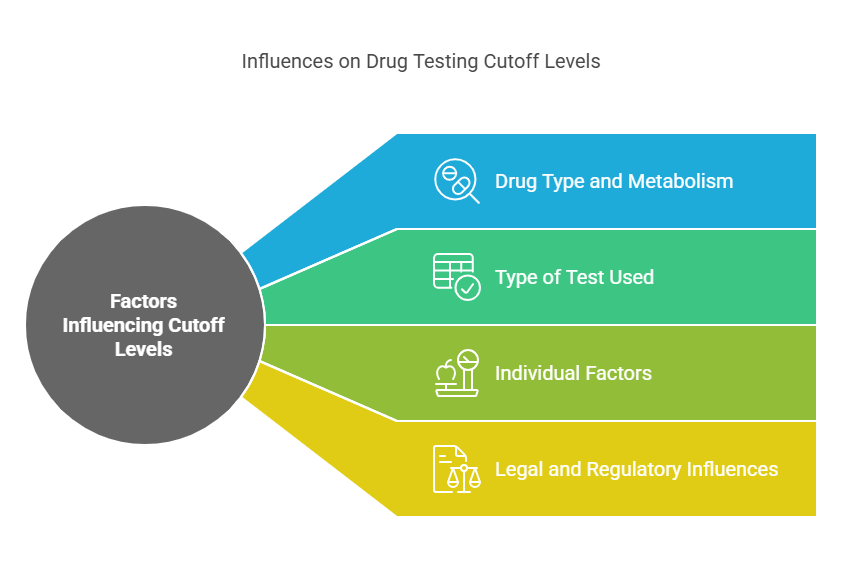
While the cutoff levels for pre-employment drug testing are defined by regulatory authorities such as the U.S. Department of Health and Human Services (HHS), various factors can influence these levels. It’s important to understand how these factors interact with testing methods to ensure accurate results.
1. Drug Type and Its Metabolism
Different drugs have different rates of metabolism, which significantly impacts the detection time in various test samples (urine, blood, saliva, or hair). For example, marijuana (cannabis) is metabolized differently from cocaine or opioids, which means the cutoff levels for these substances will vary depending on how they break down in the body and how long they remain detectable.
- Marijuana: THC, the active ingredient in marijuana, has a relatively long window of detection in urine (up to 30 days for frequent users), which leads to higher cutoff levels being set to avoid false positives. On the other hand, substances like cocaine or opioids may have a shorter window of detection, so the cutoff levels for these drugs are generally lower.
- Opioids: Prescription opioids, including oxycodone and hydrocodone, are metabolized into specific metabolites that can be detected through drug testing. Since the opioid crisis has grown in prominence, there are strict cutoff levels for detecting opioids, especially in industries with sensitive positions, such as healthcare or transportation.
- Cocaine: Cocaine metabolites are detectable in the system for a relatively short period (typically 2-4 days after use) compared to marijuana, but their higher toxicity and abuse potential lead to stringent cutoff levels for testing.
2. The Type of Test Used (Urine, Hair, Blood, Saliva)
The type of drug test used has a significant effect on the cutoff levels set for a drug screen. Different types of tests have different detection windows and are suited for detecting different substances or levels of drug use.
- Urine Testing: This is the most common method for pre-employment drug screens. Urine tests are affordable, easy to administer, and provide reliable results. However, urine tests have a detection window that can range from 1-30 days, depending on the substance and frequency of use. As a result, higher cutoff levels are used for drugs like marijuana to prevent false positives from low-level exposure.
- For marijuana: 50 ng/mL
- For cocaine: 300 ng/mL
- For amphetamines: 500 ng/mL
- For opiates: 2000 ng/mL
- Blood Testing: Blood tests are less common for pre-employment screening but offer a more accurate measure of recent drug use, often within a 24-hour window. They are more expensive than urine tests and are typically used when employers want to verify more recent drug use or impairment.
- Since blood testing typically detects the presence of drugs in real-time, cutoff levels may be lower to capture recent usage and active impairment.
- Hair Testing: Hair tests offer a longer detection window, often up to 90 days. They are especially useful for detecting patterns of chronic drug use, as substances like marijuana or cocaine are incorporated into hair follicles. The downside of hair testing is that it cannot detect very recent drug use (within the past 7-10 days), so it may not be ideal for identifying one-time or sporadic users.
- Cutoff levels for hair testing may vary by lab and drug type but are typically higher than those for urine or blood due to the long detection window.
- Saliva Testing: Saliva drug tests are often used for detecting very recent drug use, typically within a few hours to a couple of days. This type of testing is commonly used in roadside screenings or situations where rapid results are needed.
- Saliva tests have a much lower cutoff level, particularly for marijuana and cocaine, since the detection window is very short (usually within 24-48 hours after use).
3. Individual Factors: Metabolism and Frequency of Drug Use
An individual’s metabolism plays a crucial role in how long a drug stays in their system and how detectable it is in a drug test. People with faster metabolisms tend to process and excrete drugs more quickly, which could lower the concentration of drugs in their urine or blood, potentially leading to a negative result even if they recently used the substance.
- Metabolism: Faster metabolism results in the quicker elimination of drugs from the body, whereas slower metabolism can prolong the presence of drugs in the system.
- Body Fat: Some substances, such as marijuana, are stored in fat cells. People with a higher percentage of body fat may have longer detection windows for these substances, even if they are occasional users. For instance, THC can remain detectable in fat cells for a much longer period in heavier individuals.
Another factor is the frequency of drug use. A single-use of marijuana may be detectable for 1-3 days in urine, while chronic use can result in detection for up to 30 days or more. This variability necessitates the use of different cutoff levels for drugs that are used both infrequently and chronically.
4. Legal and Regulatory Influences
In addition to biological and testing factors, legal and regulatory frameworks play a significant role in defining the cutoff levels for drug screens. Federal and state regulations may dictate the specific cutoff levels that employers must adhere to, especially in industries such as transportation, healthcare, and public safety.
For example, the U.S. Department of Transportation (DOT) has its own set of cutoff levels for substances like marijuana, amphetamines, and opioids. These levels are designed to meet the specific needs of industries where safety is paramount.
Common Drug Types Tested in Pre-Employment Drug Screens
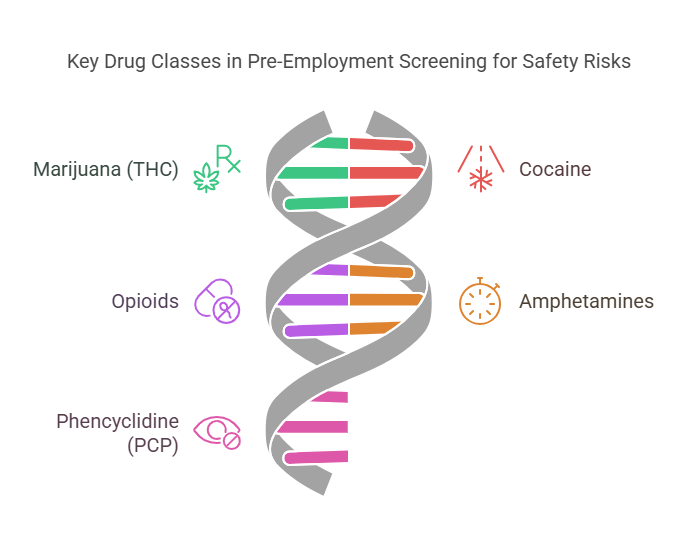
A pre-employment drug screen typically tests for several classes of drugs. These drugs are chosen based on their potential to impair a worker’s performance, pose a safety risk, or lead to absenteeism. Some of the most commonly tested drugs include:
- Marijuana (THC): Despite its growing legalization in many states, marijuana remains one of the most commonly tested drugs in pre-employment drug screens. The cutoff levels for THC are set high to avoid detecting trace amounts resulting from secondary exposure.
- Cocaine: A stimulant drug, cocaine is frequently tested in pre-employment drug screenings due to its potential for abuse and its ability to impair an employee’s ability to work safely.
- Opioids: Opioid abuse is a major concern, especially in industries where employees may be required to operate heavy machinery or vehicles. Opioids like morphine, oxycodone, and hydrocodone are commonly tested for in pre-employment screenings.
- Amphetamines: This category includes both prescription medications (such as Adderall) and illicit drugs like methamphetamine. Testing for amphetamines helps to identify individuals who may be abusing prescription medications or using illicit stimulants.
- Phencyclidine (PCP): PCP is a powerful hallucinogen, and while it is less commonly abused than some other substances, it is still included in many pre-employment drug screens due to its dangerous and impairing effects.
Exact Background Checks: Reliable Drug Testing Solutions
Exact Background Checks is committed to providing employers with reliable and accurate drug testing and background screening services. We understand the importance of fair, transparent, and legally compliant testing practices. Our services are designed to help you make informed hiring decisions while ensuring that your screening processes are conducted professionally and within the confines of the law.
- Comprehensive Testing Solutions: We offer a wide range of drug testing options, including urine, blood, saliva, and hair tests, with varying cutoff levels based on the drug type and the test method chosen.
- Customized Testing Programs: We can tailor our drug testing solutions to meet your company’s specific needs, whether you are in an industry with strict federal regulations or a private company looking for reliable screening procedures.
- Compliance and Accuracy: We ensure that all drug tests are conducted in compliance with federal, state, and local laws, as well as industry regulations, so you can feel confident that your hiring decisions are legally sound.
